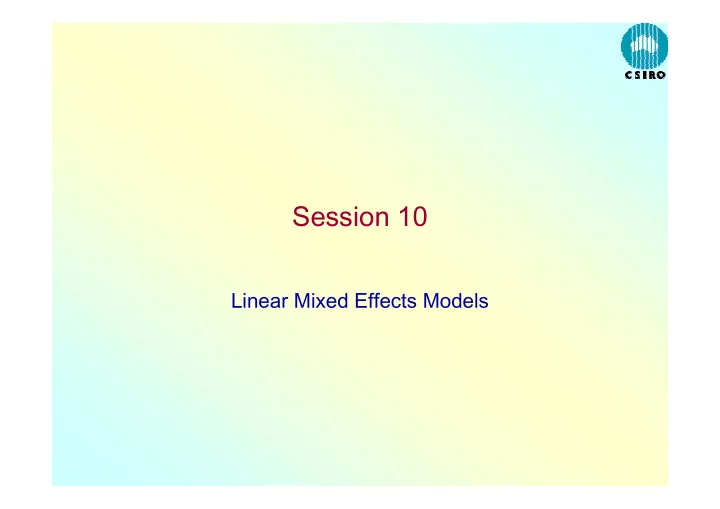

Session 10 Linear Mixed Effects Models
Example: The petroleum data of N H Prater • 10 samples of crude oil • Partitioned and tested for yield at different “end points” • The samples themselves are classified by specific gravity (SG), vapour pressure (VP) and volatility as measured by the ASTM 10% point (V10) • Problems: – Estimate the rate of rise in yield with end point – Can we explain differences between samples in terms of external measures? � � ����������������
The petrol data displayed xyplot(Y ~ EP | No, petrol, panel = function(x, y, ...) { panel.xyplot(x, y, ...) panel.lmline(x, y, col = 3, lty = 4) }, as.table = T, aspect = "xy", xlab = "End point", ylab = "Yield (%)") � � ����������������
200 250 300 350 400 450 200 250 300 350 400 450 A B C D 40 30 20 10 E F G H 40 Yield (%) 30 20 10 I J 40 30 20 10 200 250 300 350 400 450 End point � � ����������������
Can the slopes be regarded as parallel? petrol.lm1 <- aov(Y ~ No/EP, petrol) petrol.lm2 <- aov(Y ~ No + EP, petrol) anova(petrol.lm2, petrol.lm1) Analysis of Variance Table Response: Y Terms Resid. Df RSS Test Df Sum of Sq F Value Pr(F) 1 No + EP 21 74.13199 2 No/EP 12 30.32915 1 vs. 2 9 43.80284 1.925665 0.1439048 Yes? � � ����������������
Can we explain differences in intercepts? petrol.lm3 <- aov(Y ~ . - No, petrol) anova(petrol.lm3, petrol.lm2) Analysis of Variance Table Response: Y Terms Resid. Df RSS Test Df Sum of Sq F Value Pr(F) 1 SG + VP + V10 + EP 27 134.804 2 No + EP 21 74.132 1 vs. 2 6 60.67197 2.864511 0.03368118 • Looks doubtful, but how close is it? � � ����������������
Looking at all three models tmp <- update(petrol.lm2, .~.-1) a0 <- predict(tmp, type="terms")[, "No"] b0 <- coef(tmp)["EP"] a <- cbind(1, petrol$SG, petrol$VP, petrol$V10) %*% coef(petrol.lm3)[1:4] b <- coef(petrol.lm3)["EP"] palette(c("red", "blue", "orange")) xyplot(Y ~ EP | No, petrol, subscripts = T, panel = function(x, y, subscripts, ...) { panel.xyplot(x, y, ...) panel.lmline(x, y, col = 3, lty = 3) panel.abline(a0[subscripts][1], b0, col = 4, lty = 4) panel.abline(a[subscripts][1], b, col = 5, lty = 5) }, as.table = T, aspect = "xy", xlab = "End point", ylab = "Yield (%)") � � ����������������
� � ����������������
Adding a random term • The external (sample-specific) variables explain much of the differences between the intercepts, but there is still significant variation between samples unexplained. • One natural way to model this is to assume that, in addition to the systematic variation between intercepts explained by regression on the external variables, there is a random term as well. • We assume this term to be normal with zero mean. Its variance measures the extent of this additional variation � � ����������������
petrol.lme <- lme(Y ~ SG + VP + V10 + EP, data = petrol, random = ~1 | No) summary(petrol.lme) Linear mixed-effects model fit by REML … Random effects: Formula: ~1 | No (Intercept) Residual StdDev: 1.444741 1.872208 Fixed effects: Y ~ SG + VP + V10 + EP Value Std.Error DF t-value p-value (Intercept) -6.134791 14.554171 21 -0.421514 0.6777 SG 0.219398 0.146938 6 1.493136 0.1860 VP 0.545863 0.520528 6 1.048673 0.3347 V10 -0.154243 0.039962 6 -3.859697 0.0084 EP 0.157177 0.005588 21 28.127561 0.0000 … �� � ����������������
Comparison with previous model round(summary.lm(petrol.lm3)$coef, 5) Estimate Std. Error t value Pr(>|t|) (Intercept) -6.82077 10.12315 -0.67378 0.50618 SG 0.22725 0.09994 2.27390 0.03114 VP 0.55373 0.36975 1.49756 0.14585 V10 -0.14954 0.02923 -5.11597 0.00002 EP 0.15465 0.00645 23.99221 0.00000 Fixed effects: Y ~ SG + VP + V10 + EP Value Std.Error DF t-value p-value (Intercept) -6.134795 14.55411 21 -0.42152 0.6777 SG 0.219398 0.14694 6 1.49314 0.1860 VP 0.545863 0.52053 6 1.04868 0.3347 V10 -0.154243 0.03996 6 -3.85971 0.0084 EP 0.157177 0.00559 21 28.12753 <.0001 �� � ����������������
Shrinkage dat <- with(petrol, expand.grid(No = levels(No), SG = mean(SG), VP = mean(VP), V10=mean(V10), EP = mean(EP))) fixM <- predict(petrol.lm2, dat) ranM <- predict(petrol.lme, dat) conM <- predict(petrol.lm3, dat) X <- rbind(cbind(1,fixM), cbind(2,ranM), cbind(3,conM)) plot(X, axes = F, ann = F) segments(1,fixM, 2,ranM) segments(2,ranM, 3,conM) �� � ����������������
Fixed effects Random + 3 fixed 3 fixed �� � ����������������
Adding random slopes as well • The deviation from parallel regressions was not significant, but still somewhat suspicious. • We might consider making both the intercept and the slope have a random component. petrol.lme2 <- lme(Y ~ SG + VP + V10 + EP, data = petrol,random = ~ 1 + EP | No) summary(petrol.lme2) �� � ����������������
… Random effects: Formula: ~1 + EP | No Structure: General positive-definite, Log-Cholesky parametrization StdDev Corr (Intercept) 1.725640232 (Intr) EP 0.003283688 -0.535 Residual 1.854119617 Fixed effects: Y ~ SG + VP + V10 + EP Value Std.Error DF t-value p-value (Intercept) -6.229186 14.632337 21 -0.425714 0.6746 SG 0.219109 0.147941 6 1.481050 0.1891 VP 0.548118 0.523123 6 1.047781 0.3351 V10 -0.153940 0.040213 6 -3.828130 0.0087 EP 0.157248 0.005666 21 27.753481 0.0000 … �� � ����������������
Recommend
More recommend